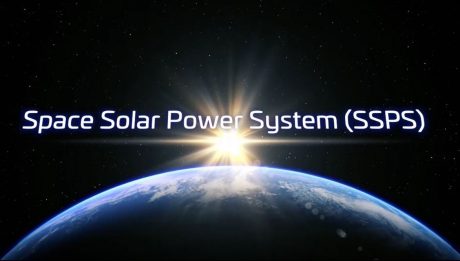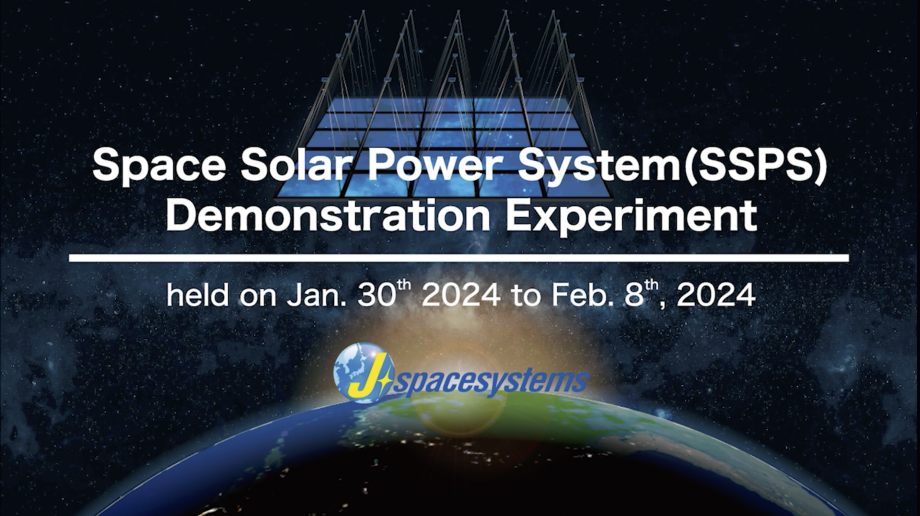
Solutions
SSPS
Space Solar Power System
Outlin
■FY2000 Research on SSPS
The studies that have been conducted on SSPS so far is overviewed.
■FY2001 – FY2002 SSPS Feasibility Study
J-spacesystems has been studying Space Solar Power System (SSPS) as an alternative future energy resource under a support of METI (The Ministry of Economy, Trade and Industry) and the other related agency for the past several years.
The study has covered from basic laboratory testing level to the practical power plant level. The activities have been supported by working committee. Participants of the committee were selected from people of wide range of backgrounds. They are experts for respective technologies working for universities, industries and research organization.
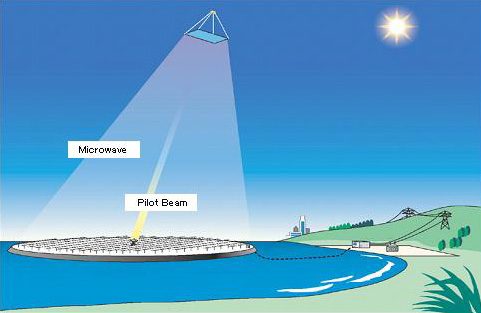
■DEVELOPMENT PLAN
Fig.1 shows proposed milestones roadmap to future commercial SSPS.
– 1st step 100kW demonstration
– 2nd step 10MW demonstration
– 3rd step 250MW demonstration
– 4th step 1GW Commercial system operation
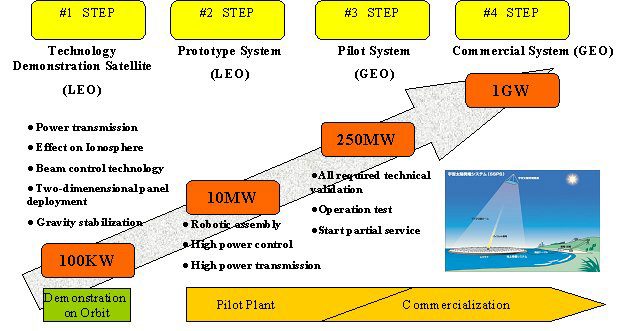
Fig.1 Milestones Roadmap
■SSPS CONCEPT
The Working Committee has investigated a simple, technically feasible, and practical configuration SSPS which consists of a large power generation/transmission panel suspended by multi-tether wires from a bus system above the panel. The upper surface of the generation/transmission panel is covered with solar cells, and the lower surface mounts transmitting phased array antenna elements and solar cells. An artist concept of the tethered SSPS is shown in Fig.2.
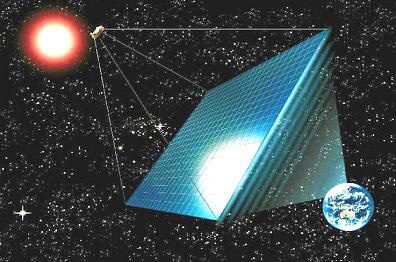
Fig.2 Artist conception of the SSPS
The attitude is automatically stabilized by the gravity gradient force in the tether configuration. So the antenna surface of the panel is always oriented towards the earth without any active attitude control. No moving structure in a large scale makes this system highly robust and stable. The power generation/transmission panel consists of identical modules, which greatly contributes to the low cost production, testing, and realizing high quality. Another innovative feature of the module is the application of wireless LAN system for the signal interface among those panels, which leads to the reliable deployment, integration, and maintenance.
Fig3 shows concept of the “Baseline type” SSPS which is capable of 1.6GW power supply maximum and 1GW average on the ground. It is composed of a power generation/transmission panel of 2.6×2.4 km suspended by multi-tethers deployed from a bus system which is located at 10 km upward. The panel consists of sub-panels of 100 mx100 m with 0.1m thickness. Each sub-panel consists of module panels 1 mx1 m size. There is no wired signal interface between module panels. The control signal and reference signal for each module panel are provided from the bus system by the wireless LAN.
The power generation of the baseline type SSPS varies with the local time as the sun angle changes as shown in Fig.4. The average power amounts to 64% of the maximum power.

Fig.3 Baseline type concept Fig.4 Baseline type electrical power
A derivative concept (“Derivative type”) is investigated to improve the average power amounts. The derivative type SSPS is shown in Fig.5. Two rotating flat mirror is attached to the bus to reflect the solar light towards the generation/transmission panel, making the average power amount to 95% of the maximum power.
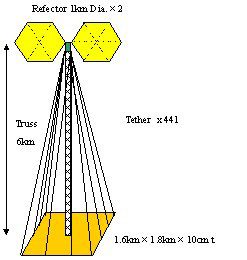
Fig.5 Derivative type concept
■LIFECYCLE CO2 EMISSION
The lifecycle carbon dioxide emission for the operational SSPS has been estimated. The result indicates that the carbon dioxide emission from the operational SSPS per unit of energy generated is almost the same as from nuclear power system and much less than fossil fuel power system, so the SSPS is one of the most effective alternative technology for further CO2 reduction in electric power generation. (Fig.6)
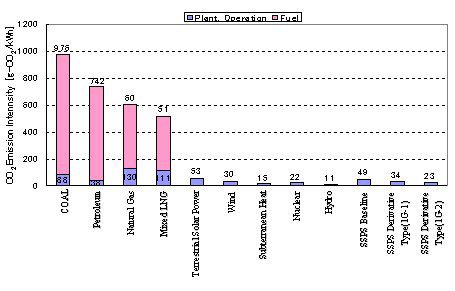
Fig.6 CO2 Emission Intensity
■FY2003 SSPS Supplemental Study
In FY2003, additional study was conducted. The study was focused mainly in the following fields:
- Space System Attitude Stability (static and dynamic)
- Methods and Feasibility of Construction on orbit
- On Orbit Operatio
Economical aspect, alternative concept, issues to be solved and so on had also been studied.
■FY2004 – FY2007 Summary of SSPS Activities
The feasibility study of SSPS has been carried out since FY2000. The study covers
(1) system definition, (2) system evaluation, (3) WPT laboratory testing. (Fig.1)
The basic SSPS concept (reference model) is a simple, technically feasible, and practical configuration with a large power generation /transmission panel (sandwich panel) suspended by multi-tether wires from a bus system above the panel.
The study has also been done for its dynamic stability, construction method on orbit, operation, economical aspect and development scenario.
The application of wireless power transmission(WPT) on the ground usage has been also studied in FY2004-2005.
As the safety and environmental assessment is a key factor to realize wireless power transmission, it has to be carried out until realization of the WPT system.
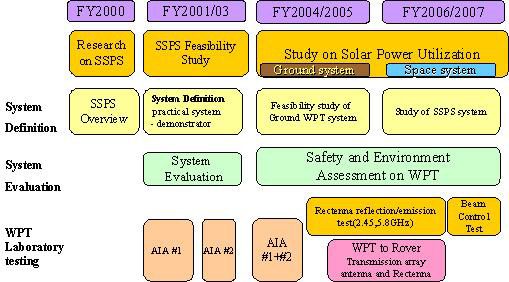
Fig.1 SSPS Study at USEF
■WPT Laboratory Testing
In order to utilize wireless power transmission, we have to consider three main elements:
- First element is generation of RF energy from the electric power.
- The second element is to send the energy to the point of interest.
- The last element is the receiving RF energy and converting it to DC electric power.
In addition to these elements, we have to understand and control unwanted emission and reflection of RF energy. We have covered these elements in our testing in some extent.
Beam Control Experiment
The beam control experiment was initiated from 2001. The active array panel with phase shifters, AIA#1, and the hardware retro-directive active integrated array panel, AIA#2, were developed and tested. The combination transmission test was also carried out.
The purpose of the development was to understand the issue derived by the microwave beam steering with integrated panels. And its evaluation was carried out in the anechoic chamber of METLAB, which is the microwave power transmission experiment facility of the Kyoto University. Fig 5 shows experiment in test facility.
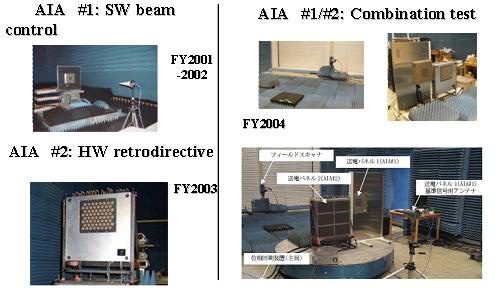
Fig 5 Experiment of AIA #1 and AIA#2
In 2007, high accurate beam control experiment was carried out using the phased array antenna (5.8GHz, one-dimensional, 12 elements, about 40 cm wide).
Also, experiment of synchronized reference control system by closed loop technique for multiple phased array panels were carried out.
■WPT to Rover
The WPT to remote object is a preferable application of SSPS technology. The rectenna array for rover, light weight phased array panel for transmitter on 5.8GHz had been developed. We also confirmed the low power command communication, 10mw, in 100W level microwave power transmitting condition. (Fig.6)
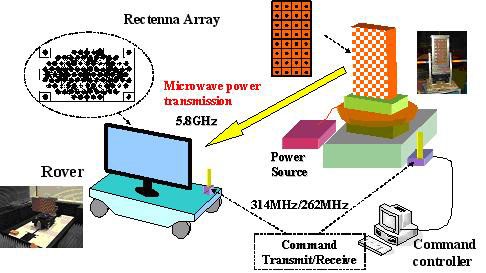
Fig 6 WPT experiment to rober
■Phased Array Panel for the Transmission
Light weight transmitting panel is a key element for SSPS. As the output power level of each antenna element was about 4W therefore about 120 W output power was achieved with the 4kg weight. Therefore we have achieved weight to output power level of 33g/W. It included signal generation but did not include beam steering mechanism. The panel consist of 32 antenna element with array of three stages amplifiers. (Fig.7)
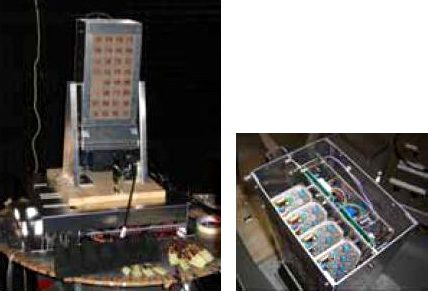
Fig.7 Phased array panel for the transmission
■Rectenna array panel for the Rover
Fig.8 shows developed rectenna array for the rover. The size is 340 x 600mm. The number of rectenna elements is 97. Weight is 2.5kg. Spacing between elements is 0.774λ.
Fig.9 indicates array test result. Rectenna arrays are composed of 3 blocks (in each block power density is different) and these blocks are connected in series. Efficiency of the rectenna array is about 65%.
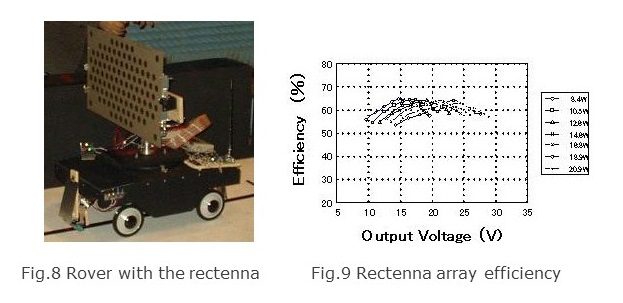
Fig.10 indicates the condition of the buffer battery charge. Fig.11 indicates circular test course of the rover. The rover tracks the black tape in this picture. Command from outside can determine if the rover should move or stop.
Climbing line in Fig.10 shows that the coming microwave power is sufficient. It can move the rover and charge the battery. Descending line indicate that the battery is discharged at this period. Starting and stopping rover indicates that the command communication worked between the rover and command equipment located outside of the system.
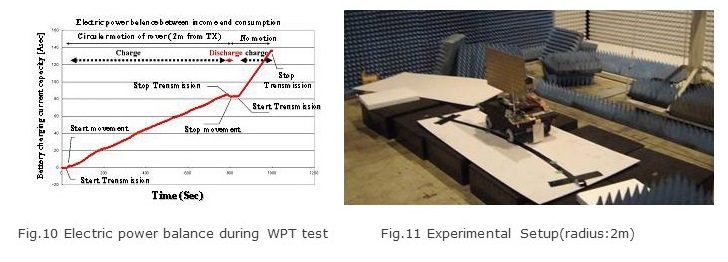
■SSPS Reference Model
It is not easy for a huge system like FY2002 reference model (Fig.2) to get financial support at one time. Then the working committee has newly proposed the multi bus type of SSPS (Fig.3) in FY2006. Units of Tethered-SSPS are integrated one by one and finally to the commercial plant of 1 GW level Integrated Tethered-SSPS with multiple buses. Though it is in the process of construction, it works as a single SSPS.
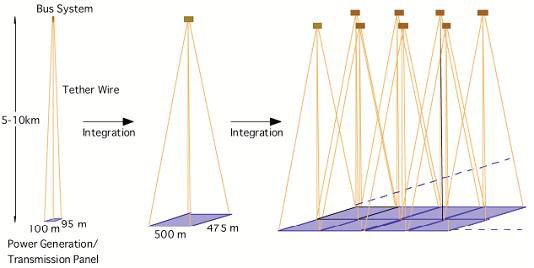
Fig.3 FY2006 Reference Model
Fig.4 shows the layered structure of transmitting panels. They are sub-array (the smallest element, 0.125m x 0.125m with 16 antenna elements), module(0.5m x 0.5m), SSPS unit(100m x 95m), unit assembly (500m x 475m), and SSPS system (2500m x 2375m). The target thickness of the panel is 0.02m.
Growing development of the system can apply up-to-date technology in all elements of the system.
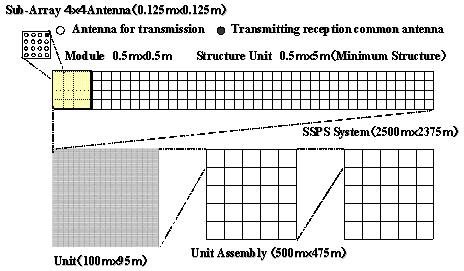
Fig.4 Layered structure of transmitting panels
■FY2009 – SSPS on new space policy and Plan
The new space policy was enacted in 2008 and the new space plan was established in 2009. They have selected 5 practical space systems to realize and 4 research development programs to promote. Space Solar Power system program was selected as one of 4 research development plans.
Following issues were included relating to SSPS:
- Necessary technologies for SSPS shall be studied and developed.
- The prospects for practical use shall be investigated in about 10 years.
- Agencies shall work together to conduct a comprehensive study.
- Ground WPT demonstration shall be conducted.
■New demonstration and validation plan:
New development plan for Ground microwave WPT has started in 2009.Fig.12 shows new Ground WPT system plan. The new plan is funded by METI. The plan will be conducted with JAXA team.
The system is intended to demonstrate microwave beam control and microwave wireless power transmission with about 50 m distance and kilo watts level transmission power. It has following characteristics:
- The Frequency is in 5.8GHz ISM band.
- Four Phased Array Panels. One panel consists of 76 sub arrays. One sub array consists of 4 transmission elements.
- As the final configuration is space use, the thickness and weight of the panel will be reduced. Target thickness is about 40 mm. The final amplifiers in each elements are all solid state.
- REV method, rotating-element electric-field vector method, will be applied for phase control f the elements.
- Software Retro-directive will be applied to control the direction of the transmission microwave power. Pilot signal detection and retro-directive direction pointing with phase shifter is JAXA’s role.
- Rectenna array panels for effective RF-DC power conversion will be developed.
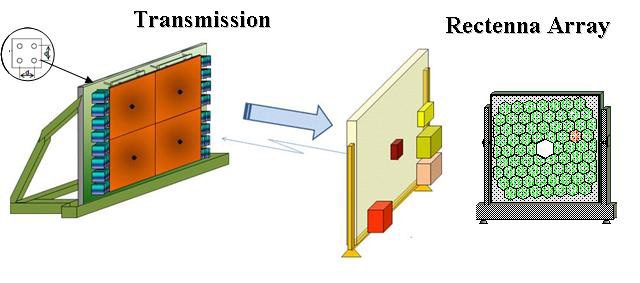
Fig 12 New Ground WPT configurati
Download
Event
-
Space Solar Power System (SSPS) Demonstration experiment
This image was created by "Research and Development Project on High Efficiencies of Wireless Electric Power Transmission by Space Solar Power System 2020"funded by the ministry of Economic, Trade and Industry of Japan.
Space Solar Power System (SSPS) Demonstration experiment


